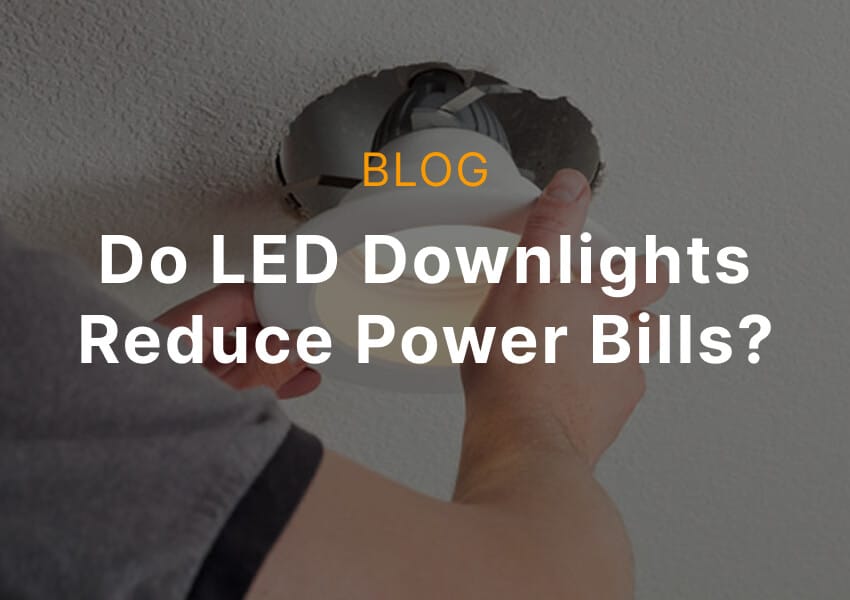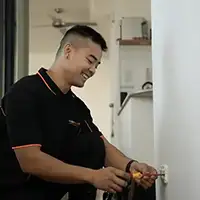Flickering lights can be annoying, but they may also signal a deeper electrical issue. If you’ve asked yourself “why is my light flickering and how to fix it,” you’re not alone. This guide by Powerhub Electrical will help you understand the common causes of flickering, what checks you can do safely, and when it’s time to call a licensed electrician. Your home’s safety could depend on it.

Is Flickering a Sign of a Bigger Problem?
Not all flickering lights are dangerous. Sometimes the cause is as simple as a loose bulb. However, in other cases, flickering may indicate a serious electrical fault. It’s important to understand the difference between a harmless nuisance and a hazard that could compromise home safety or signal wiring issues.
When It’s Likely Harmless
- Loose globe: A poorly seated bulb may flicker intermittently, especially if it’s been bumped or isn’t screwed in tightly.
- LED compatibility: Some LED lights flicker when used with dimmers not designed for them.
- Dimmer mismatch: Using the wrong type of dimmer switch for your lighting can cause visible flicker or buzzing.
When It Could Be Dangerous
- Flickering across multiple rooms: This could point to voltage fluctuations or a switchboard fault.
- Sparks or burning smells: These are urgent signs of potential overheating or exposed wiring.
- Flicker worsens when appliances are used: A clear indicator of an overloaded circuit or voltage dip.
Common Causes of Flickering Lights
Flickering lights can happen for several reasons. Here are some of the most common causes:
- Loose bulb or fitting: The bulb may not be screwed in properly or the fitting may have worn contacts.
- Faulty light switch: Old or damaged switches can cause intermittent flickering when the contacts fail.
- Dimming switch incompatibility (especially with LEDs): Many dimmers aren’t compatible with LED bulbs, which can lead to inconsistent brightness.
- Voltage drops from appliance use (fridge, air conditioner): Large appliances turning on can momentarily lower voltage on a circuit, causing lights to dim or flicker.
- Loose wiring or faulty circuit: A potentially dangerous fault that may cause flickering, arcing, or overheating.
- Outdated or overloaded switchboard: Older switchboards may not handle modern electrical loads, leading to system instability and flickering lights.

Step-by-Step: How to Troubleshoot a Flickering Light
There are a few safe steps you can take as a homeowner before calling an electrician. These checks can help identify whether the flickering is minor or something more serious.
Step 1 – Turn Off Power and Inspect the Globe
Switch off the power at the wall and carefully remove the bulb. Check if it’s loose or has visible damage. Screw in a new globe to see if the issue is resolved. Make sure the replacement is the correct type and wattage for the fitting.
Step 2 – Test Another Fitting
Insert the bulb into a different light fitting in another room. If the flickering continues with the same bulb, the issue is likely the globe. If not, the original fitting or circuit could be faulty.
Step 3 – Check for Pattern or Frequency
Observe when the flickering occurs. Does it happen when your air conditioner or fridge turns on? Is it isolated to one room or area of the house? These patterns help determine if the issue is localised or circuit-wide.
Step 4 – Avoid DIY Electrical Work
Never attempt to open switches, light fittings, or wiring yourself. In Australia, it’s illegal and unsafe to tamper with fixed electrical systems without a licence. If you suspect a wiring fault, call a licensed electrician.
When You Should Call an Electrician
Professional help is recommended when any of the following occurs:
- Flickering affects multiple lights or rooms
- Switches feel warm, make buzzing noises, or spark
- Flickering becomes more frequent or severe
- The property has old wiring or a fuse box instead of circuit breakers
- Light fittings feel unusually hot to touch
Powerhub Electrical can inspect and resolve these issues safely and legally across Sydney.
How to Prevent Future Flickering Issues
Preventing flickering lights starts with good electrical practices and routine maintenance. Here are a few tips:
- Use high-quality LED globes and compatible fittings
- Avoid plugging too many high-wattage devices into a single circuit
- Schedule regular electrical safety inspections by a licensed electrician
- Don’t use dimmer switches unless they’re LED-compatible
- Upgrade old switchboards to handle modern load requirements
Not Sure What’s Causing the Flicker?
Flickering lights can be caused by minor issues, or signal something more serious. If you’re unsure, it’s best to have the problem checked by a licensed electrician. Powerhub Electrical offers assessments across Sydney to help ensure your home’s electrical system is safe and compliant.

Frequently Asked Questions
Is it dangerous if my light flickers occasionally?
Occasional flickering may not be dangerous, especially if caused by a loose bulb or temporary power fluctuation. However, if it becomes more frequent, affects multiple lights, or is accompanied by buzzing or smells, it’s important to have it checked. Persistent flickering could point to a deeper fault in your home’s wiring or electrical circuits.
Can a faulty dimmer cause flickering?
Yes. Many older dimmer switches are not compatible with LED bulbs. This mismatch can cause the lights to flicker, hum, or not dim properly. Upgrading to an LED-compatible dimmer usually resolves the issue. A licensed electrician can check and replace the switch safely if needed.
Do LED lights flicker more than other bulbs?
LEDs can be more prone to visible flickering, especially when used with incompatible dimmers or in circuits with fluctuating voltage. However, high-quality LED globes with proper fittings and suitable dimmers should not flicker under normal conditions. Using recognised brands and ensuring compatibility reduces this risk.
Can I fix flickering lights myself?
You can safely check and replace the globe, test it in another fitting, and observe patterns of flickering. However, anything involving wiring, switch replacements, or circuit testing must be done by a licensed electrician. Attempting to fix electrical systems yourself is illegal in Australia and can be very dangerous.





